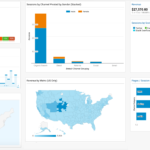A Deep Dive into Google Analytics 4: What You Need to Know
Google Analytics (GA) has long been the gold standard for web analytics, offering invaluable insights to marketers, website owners, and business leaders. The launch of Google Analytics 4 (GA4) heralded a new era of data analysis and insights. If you’re wondering what’s so special about GA4 and how it differs from its predecessor, Universal Analytics, you’re in the right place.
1. What is Google Analytics 4 (GA4)?
GA4 is the latest iteration of Google Analytics, designed from the ground up to offer more intelligent insights, better integration with Google Ads, and a more user-centric model to help businesses better understand their customers.
2. Event-based Tracking
One of the most significant shifts in GA4 is its event-based tracking model. Unlike Universal Analytics, where sessions and pageviews dominated, GA4 tracks user interactions as events. This could be anything from scrolling a page, watching a video, or even moving the mouse. This granular data allows for more comprehensive insights into user behavior.
3. User-centric Data
GA4 provides a more holistic view of how users interact with your site or app. It places a strong emphasis on user journeys, enabling businesses to understand the paths users take and where they drop off. This focus helps businesses improve user experience by identifying and fixing friction points.
4. Improved Audience Building
Building and defining audiences in GA4 is much more sophisticated than before. You can combine multiple criteria, including past on-site behavior, predicted future actions, and more, to create highly targeted audience segments. These segments can then be directly integrated with Google Ads for more effective retargeting.
5. Enhanced Reporting
The reporting interface of GA4 is different and may take some getting used to. But, once familiarized, it offers a more intuitive and customizable experience. You can drag and drop various metrics to create bespoke reports, and the Exploration report in GA4 allows for deep dives into your data.
6. Cross-platform Tracking
For businesses with both a website and a mobile app, GA4 provides unified tracking across platforms. This cross-platform view allows you to see a unified customer journey, regardless of where they interact with your brand.
7. Predictive Metrics
Harnessing the power of machine learning, GA4 provides predictive metrics like the potential revenue you could earn from a particular segment of users. This feature helps businesses prioritize their marketing efforts for maximum return.
8. Lifespan Control of User Data
With increasing concerns about user privacy and data retention, GA4 allows website owners to set the duration for which user data is retained. This added control ensures businesses can comply with data protection regulations and build trust with their users.
9. Free BigQuery Integration
For those seeking advanced data analysis, GA4 offers a free integration with Google’s BigQuery. This is especially beneficial for large businesses dealing with massive datasets, as it allows for in-depth, customizable analysis.
10. The Future in Mind
It’s clear that GA4 is not just an incremental upgrade. It’s a reimagining of what Google Analytics should be, considering the evolving digital landscape, mobile-first user behavior, and increasing importance of user privacy.
Conclusion
Google Analytics 4 is more than just a new version; it’s a paradigm shift. By focusing on user-centric data, event-driven metrics, and incorporating machine learning, GA4 offers businesses of all sizes a tool to deeply understand their audience and make data-driven decisions. If you haven’t yet made the switch or started your GA4 journey, now is the time to dive in. As with all tools, its real value comes from understanding its features and leveraging them effectively for your business needs.




